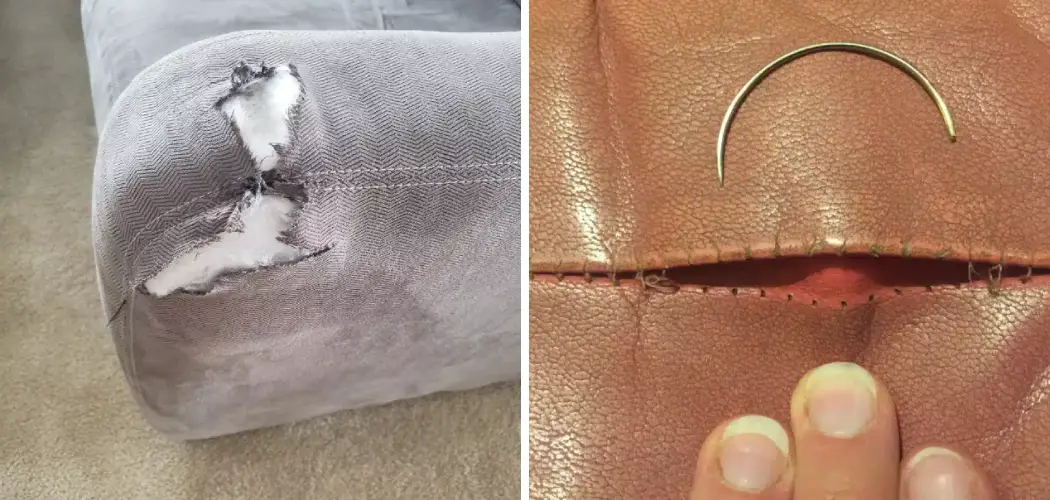Discovering a rip in your couch seam can be disheartening, but the good news is that with the right techniques, you can mend the damage and restore your sofa to its former glory. A ripped couch seam not only compromises the aesthetic appeal of your furniture but also risks further tearing and wear.
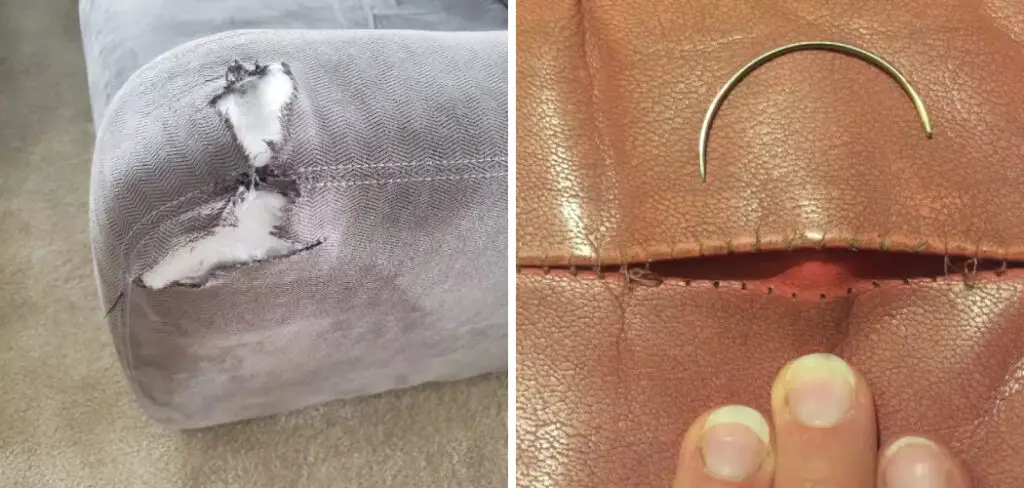
In this comprehensive guide on how to fix a ripped couch seam, we delve into the art of repairing a ripped couch seam, exploring step-by-step methods that cater to different types of upholstery. Whether your couch is leather, fabric, or another material, understanding how to fix a ripped seam will empower you to address the issue promptly and effectively.
From basic sewing skills to more advanced techniques, embark on a journey to revive your couch and prolong its lifespan, turning a potential eyesore into a skillfully repaired focal point in your living space.
The Importance of Repairing Ripped Couch Seams
Repairing a ripped couch seam goes beyond cosmetic appeal; it’s about preserving the integrity of your furniture. A tear left unaddressed can widen, compromising the structure of the sofa and leading to more expensive repairs or even the need for a replacement.
Timely mending prevents the stuffing from escaping, which can lead to an uneven shape and discomfort. More than just maintaining appearances, fixing seams is essential for the longevity and functionality of your couch, ensuring that it remains a comfortable and inviting centerpiece in your home for years to come.
Common Causes of Ripped Seams
Several factors could be responsible for the frustrating issue of ripped seams on a couch. Everyday wear and tear is the most common culprit, as the stress of regular use gradually weakens the fabric at the seams. Heavier usage areas, like cushion edges and armrests, are particularly susceptible.
Pets can also pose a threat to your furniture with their claws and teeth, potentially puncturing and tearing the upholstery. In addition, substandard materials or craftsmanship may give way sooner under normal conditions, leading to early tear incidents.

Environmental factors like exposure to sunlight and humidity can further degrade the fabric, contributing to the susceptibility of the seams. By understanding these common causes, you can take proactive steps to prevent damage and keep your couch seams in good repair.
Understanding Couch Seam Construction
Before diving into repair work, it’s crucial to understand the anatomy of a couch seam. Couch seams are the points where different pieces of upholstery fabric are stitched together to create a uniform covering for your furniture.
They are strategically placed to withstand stress but also to maintain the couch’s shape and appearance. Seams are often double-stitched or reinforced for extra durability, and the thread used is typically heavy-duty to accommodate the wear and tear of daily use.
Depending on the furniture’s design, some seams might be hidden, while others are visible as part of the sofa’s style. In leather couches, seams serve both functional and decorative roles, with some patterns adding to the piece’s overall aesthetics. Recognizing the type of seam and fabric on your furniture is the first step in performing a successful repair.
Types of Couch Seams
When approaching the task of repairing a ripped seam, it’s helpful to identify the specific seam type involved. There are several seam types utilized in couch construction, each with its own characteristics and methods of repair.
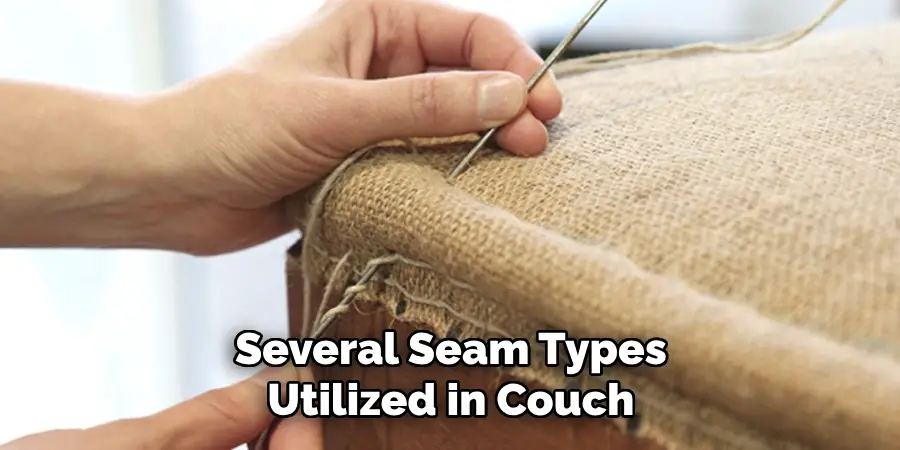
Welted Seams are characterized by a cord encased in fabric, which is sewn along the seam. This type is often used for aesthetic appeal and additional reinforcement.
Topstitched Seams reflect a design choice where stitch lines are purposely visible on the outside of the fabric to add detail and strength.
Plain Seams are the most basic type, where two pieces of fabric are simply sewn together. They are less durable than the other types and may rip more easily.
Piped Seams, similar to welted seams, have a corded edge that is sewn into the seam. Piping is often used for definition and detail on edges.
Frenched Seams give a neat finish as the raw edges of the fabric are fully enclosed, making them strong and less prone to fraying.
Overlocked Seams use a serger machine that trims the edge of the fabric and encases it in thread. This method is commonly found in modern furniture and provides excellent resistance to fraying and tearing.
Knowing the type of seam you are working with will guide you in choosing the appropriate repair techniques and materials to ensure a durable and aesthetically pleasing fix.
Materials Used in Couch Construction
The longevity and resilience of your couch not only hinge on the quality of its construction but also on the materials from which it is made. The fabrics employed in upholstery range from natural fibers like cotton and linen to synthetic options such as polyester and microfiber, each with their own set of benefits and shortcomings.
Leather, esteemed for its durability and ease of cleaning, stands apart as a premium material. Beneath the outer covering, foam or feather stuffing ensures comfort, while springs and webbing provide foundational support. The frame, typically constructed from wood or metal, is the backbone of the furniture, determining its structural integrity.
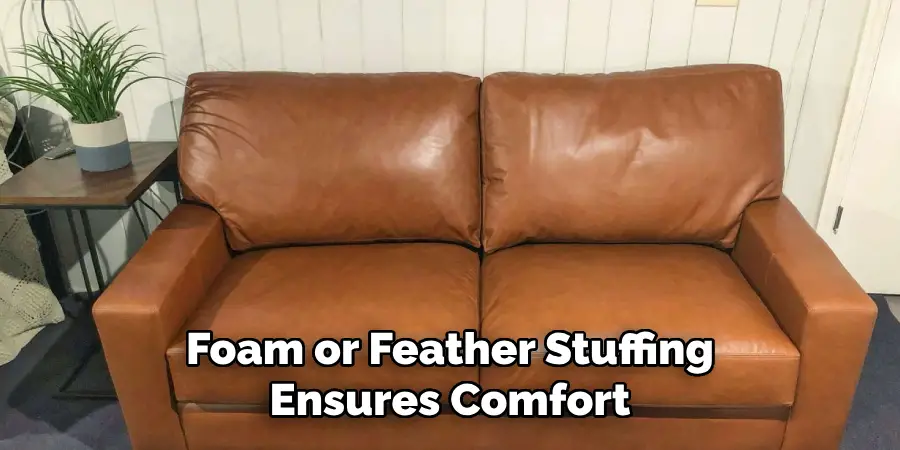
Identifying the materials used in your couch will not only give you insight into the best methods for repair but also inform your choices for preventive care to avoid future damage.
Factors Affecting Seam Integrity
Several elements contribute to the integrity of couch seams and understanding these can help prevent future damage. The quality of thread used in stitching can greatly influence seam strength—higher quality thread will resist breaking under tension better than cheaper options.
The stitch length and type also play a pivotal role; shorter stitches can provide a stronger hold, while lock stitches may offer more durability than chain stitches. The tension applied during sewing is essential; too much can cause the thread to break, while too little can result in a loose seam that easily comes apart.
Usage patterns, such as the frequency and manner in which the couch is used, can cause varying degrees of stress on different seams, leading to potential weaknesses. Lastly, environmental factors like fluctuating temperatures and humidity levels can affect both the fabric and thread, altering their properties and potentially compromising seam integrity over time. Understanding these factors allows for a more targeted approach to both repair and routine maintenance, ensuring the longevity of your furniture.
10 Methods How to Fix a Ripped Couch Seam
1. Hand Stitching with Needle and Thread:
For smaller rips in fabric upholstery, hand stitching with a needle and matching thread is a classic and effective method. Thread a needle with a double strand of thread, knot the end, and carefully stitch the torn edges together using a simple running stitch or a more intricate backstitch.
If the tear is too large to stitch closed, you can use a patch of fabric or an iron-on fabric repair patch to cover the area and then stitch around the edges for reinforcement.
When hand stitching, it’s important to keep your stitches small and close together for maximum strength. Using a thimble can help protect your finger while pushing the needle through thicker fabrics. Also, be sure to secure the beginning and end of your stitching with a knot to prevent it from unraveling.

2. Sewing Machine Repair:
Larger fabric tears or seams that require more stability benefit from using a sewing machine. Select a heavy-duty needle and matching thread for the fabric. Align the ripped edges and use a straight or zigzag stitch on the sewing machine to create a secure and durable mend.
If you’re a fan of sewing, then you know how important it is to maintain your sewing machine. Whether you sew as a hobby or for your profession, it’s crucial to keep your machine in good working condition. However, sometimes even the most well-maintained machines can experience issues that require repair.
Sewing machine repair may seem daunting at first, but with the right tools and knowledge, you can easily fix most common problems. Some of the most common issues include thread jams, needle breakage, and tension problems. These can be caused by a variety of factors such as using incorrect needles or thread, improper threading of the machine, or build-up of lint and dust.
3. Fabric Glue or Adhesive:
Fabric glue or adhesive can be an efficient solution for repairing small tears in fabric upholstery. Apply the adhesive to the torn edges, press them together, and let the glue dry thoroughly. Ensure that the adhesive is suitable for your specific fabric type, and follow the product’s instructions. Additionally, it is essential to test the adhesive on a small, inconspicuous area of the fabric before using it on the torn area.
Fabric glue or adhesive can also be used to attach patches or embellishments to fabric, giving new life to old garments. This type of glue usually dries clear and flexible, making it ideal for use on fabrics without leaving any visible residue. However, it is crucial to note that fabric glue or adhesive should not be used as a permanent solution for repairing large tears or holes in upholstery.
4. Iron-On Fabric Patches:
Iron-on fabric patches are convenient for fixing larger tears in fabric upholstery. Trim the patch to fit the torn area, place it over the rip, and use a hot iron to activate the adhesive on the patch, bonding it to the fabric. This method provides both reinforcement and a seamless finish. Fabric patches are also great for covering up stains or holes in clothing, making them an easy solution for wardrobe malfunctions.
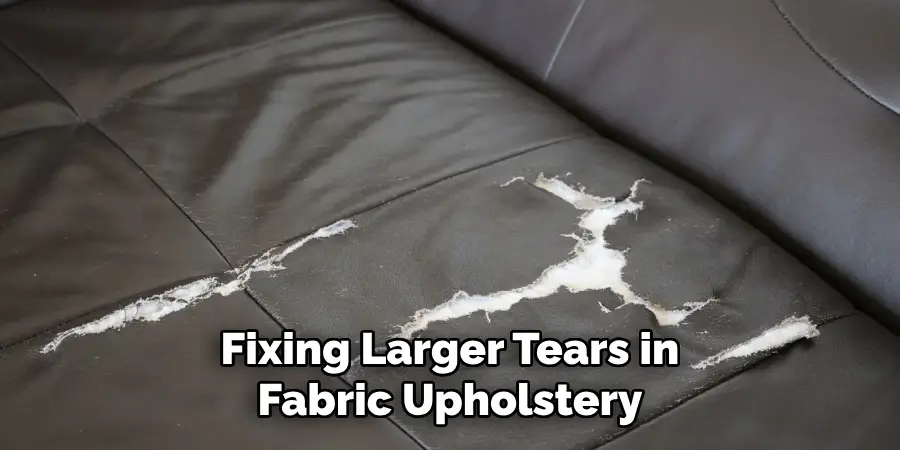
When choosing a fabric patch, make sure to select one that is similar in weight and texture to your damaged item. This will ensure that the patch blends in well with the surrounding fabric and does not look out of place. You can find pre-made fabric patches at most craft or fabric stores, or you can create your own by cutting a piece of fabric to the desired size and using iron-on adhesive to secure it to the damaged area.
5. Leather Repair Kit:
Leather couches require specialized attention. A leather repair kit typically includes a filler compound, color-matching materials, and tools for repairing small to moderate tears. Clean the damaged area, apply the filler, and use the color-matching components to seamlessly blend the repair with the surrounding leather.
Leather furniture can be a beautiful addition to any home, but it’s important to keep in mind that it requires specific care. Unlike fabric couches, leather is not as forgiving when it comes to wear and tear. That’s why having a good quality leather repair kit on hand is essential for maintaining the appearance of your leather furniture.
6. Leather Stitching with Needle and Thread:
Similar to fabric, leather rips can be stitched by hand using a needle and strong waxed thread. Align the torn edges, thread the needle with a double strand of thread, and carefully stitch using a saddle stitch for added durability. This method works well for repairing seams on leather couches.
To properly stitch leather, you will need to use a specialized leather needle with a sharp point and larger eye to accommodate the thicker thread. It’s important to choose a strong and durable thread such as waxed polyester or nylon for better grip and longevity.
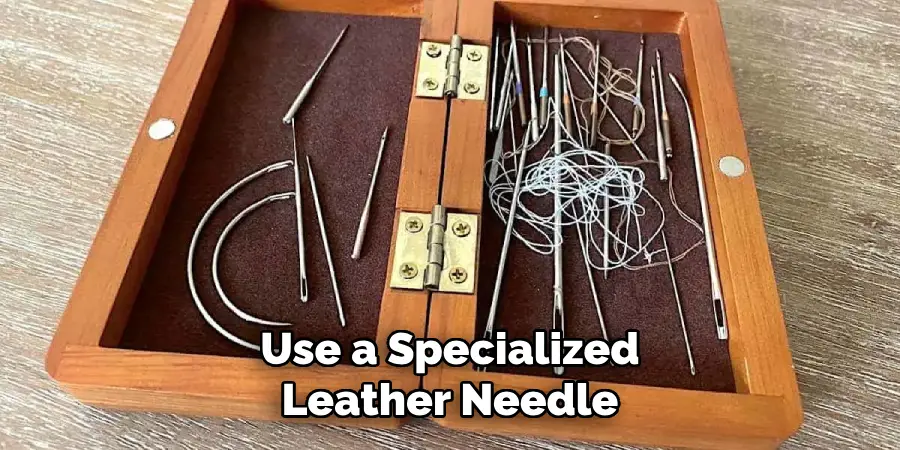
Before starting the stitching process, it’s helpful to make small holes along the seam using an awl or leather punch. This will make it easier to guide the needle through and prevent excess puncturing of the leather.
7. Leather Adhesive or Glue:
Leather-specific adhesives or glues can be applied to mend smaller tears in leather upholstery. Clean the damaged area, apply the adhesive, and press the torn edges together. Ensure the adhesive is compatible with your type of leather, and allow sufficient drying time for a secure bond.
If you’re not confident in your ability to repair the leather yourself, it’s always best to seek professional help. A skilled and experienced leather repair specialist will have the necessary tools and knowledge to mend larger tears or replace sections of damaged leather.
When choosing a leather adhesive, be sure to read reviews and select one that has been proven effective for repairing upholstery. Some adhesives may have a strong odor, so be sure to use them in a well-ventilated area.
8. Patching with Leather:
For larger leather tears or when a seamless repair is challenging, consider patching with a matching piece of leather. Trim the patch to fit the torn area, glue it in place using leather adhesive, and carefully blend the edges for a cohesive appearance. This method works well for inconspicuous repairs.
To begin, gather the necessary materials for patching. You’ll need a matching piece of leather, scissors or a knife to trim the patch, and leather adhesive. The adhesive will provide a stronger bond than regular glue, ensuring that your patch stays in place.
9. Upholstery Tape for Quick Fixes:
Upholstery tape is a quick and temporary solution for small fabric rips. Cut the tape to size, apply it over the torn area, and press down firmly. While not a long-term fix, it can provide a temporary solution until a more comprehensive repair can be undertaken.
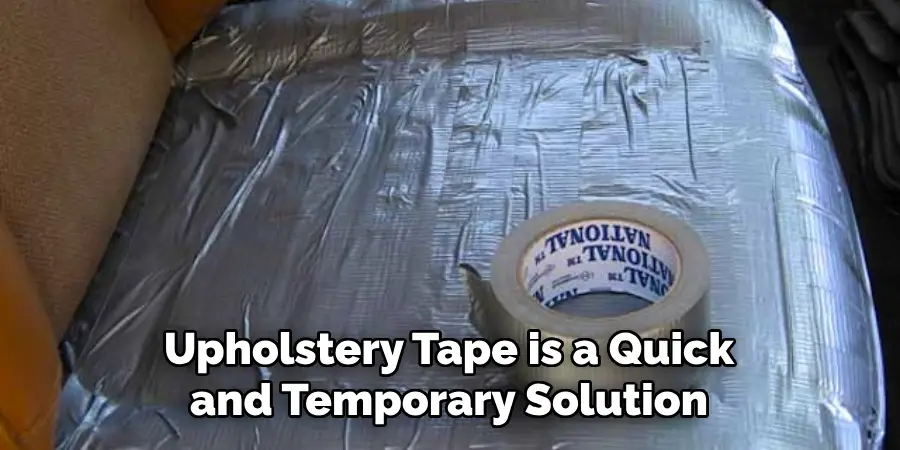
Upholstery tape is a handy tool to have in your repertoire for quick fixes. It can be used on a range of fabrics, including leather, vinyl, and fabric upholstery. Whether you accidentally rip your favorite chair or want to hide a small tear in your couch, upholstery tape can give you peace of mind until you have the time and resources for a permanent repair.
10. Professional Upholstery Repair Services:
For complex or extensive damage, seeking the expertise of professional upholstery repair services is advisable. Experienced technicians can assess the extent of the damage, recommend appropriate repair methods, and ensure a high-quality, lasting restoration of your couch seam.
Furthermore, hiring professional upholstery repair services can save you time and effort as they have the necessary tools and materials on hand to complete the repairs efficiently.
Professional upholstery repair services also have access to a wider range of fabrics and materials, making it easier to find an exact match for your damaged couch. They are also knowledgeable about different types of fabric and their specific care requirements, ensuring that the repair process does not cause further damage.
Conclusion
In conclusion, mastering the art of fixing a ripped couch seam revitalizes the integrity and appearance of upholstered furniture, prolonging its lifespan and enhancing comfort. By understanding the causes of ripped seams and employing the outlined repair techniques, individuals can effectively mend upholstery damage and prevent further deterioration.
Whether opting for hand stitching methods, machine techniques, or adhesive solutions, it’s essential to approach the repair process with care and attention to detail. Post-repair care, including testing seam integrity and applying protective coatings, ensures the longevity and durability of the repair.
Hopefully, this article gave you some helpful tips about how to fix a ripped couch seam successfully, so now that you have the proper knowledge on how to get the job done, why not give it a try today?

